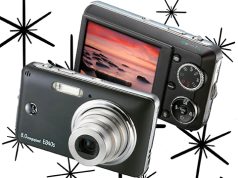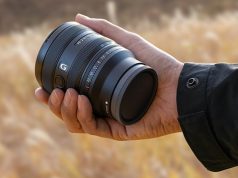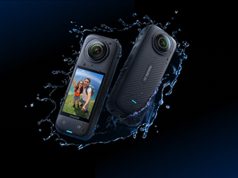
During lunch one day this summer, I took a break from the dreary news shows to catch a few innings of the Little League World Series. It took me back, and it also took me by surprise. As the TV cameras moved through the crowds, I noticed many of the parents and fans, undoubtedly of the amateur photographer ilk, making pictures with real live cameras; there were relatively few cameraphones in evidence.
The reason these parents and fans at Williamsport chose cameras over cameraphones is obvious. Real cameras have features and optics that can catch precious moments on the distant field. And while the cameras they used were a long way off from what you’d see in the press box, they all looked lightweight and easy to operate. They could capture close shots of kids at bat as well as easily follow the action on the bases. “Program” or easy mode shooters? Sure, but what need do they have of HDR, RAW file format and complicated menus and modes that might get in the way?
The same scenario goes for soccer moms; for those who love bird photography but aren’t ornithologists; for travelers who want to limit their gear’s size (and coincidentally fit it in their carry-on and hotel safe); and for day hikers and nature lovers whose backpack weight is a strong consideration.
Enthusiasts and pros garner lots of industry attention with ever-more complicated cameras and high-res sensors, and price tags to match. However, it strikes me that we should consider refocusing on what once was the backbone of the industry—the avid amateur. The growth we seek may not be at the top end but bottom-up.
The Amateur/Beginner Audience
For many folks in this segment there’s need for a simple (read “uncomplicated”) camera that allows them to frame even in bright light. They need a camera that offers a fair zoom range (somewhat wide to, say, an equivalent of 100–135mm) and is eminently portable.
Whenever I visit my local camera store, I wait my turn and discreetly eavesdrop on the “qualifying conversations” between salesperson and customer. I pay closest attention to those who want to step up from their cameraphone and fit the amateur (read beginner) profile. Soon, a range of cameras sit on the counter; I watch as the potential buyer’s eyes glaze over when the salesperson gets deep into the menu, with all the options, buttons and modes an “advanced” camera affords.  In many instances, these higher-end models are daunting. As a result, the buyer, who simply wants a camera that takes good pictures of their travels, family and a remembrance shot of a great hike, just shakes her head. The killer is often the price point. Upselling has its time and place. But the main object should be helping consumers find a camera they can handle, that satisfies their needs and that they can afford. Hopefully then, we’ll see them again down the road when they are ready for the next step.
In many instances, these higher-end models are daunting. As a result, the buyer, who simply wants a camera that takes good pictures of their travels, family and a remembrance shot of a great hike, just shakes her head. The killer is often the price point. Upselling has its time and place. But the main object should be helping consumers find a camera they can handle, that satisfies their needs and that they can afford. Hopefully then, we’ll see them again down the road when they are ready for the next step.
A Hard Search
This is all well and good. However, with the dearth of true camera stores in small markets, venues where counter folks do their best to make a match, I am concerned the beginner can find themselves at sea when doing online research to find the right camera (and lens) that matches their pocketbook and needs.
Given this scenario, I checked into a number of camera company sites to see how they help the “step-up from cameraphone consumer” along. I also looked at what they currently have on offer for this buyer. What follows is a brief tour of the “majors” and some comments on their sites.
I limited my search to camera/lens combos (integral or interchangeable) that came in under $700; that’s the price of a good cameraphone as well as a fair ceiling on what an amateur might want to spend. In truth, I’d prefer the top end to be $500, but that yielded much fewer hits.
I also took camera complexity into account. I eliminated super-zoom “bridge” models; their focal length ranges, while seductive, are generally beyond the needs of our beginner. Would you sell a beginner a body and then try to have them add on a lens that racks out beyond 500mm?
An Internet Tour
Canon USA
Canon has a helpful self-qualifying checklist for their camera offerings. It starts with a sliding budget scale; I put in under $700. It then offers a range of experience levels: from advanced to beginner; I chose the latter.
Up popped a series of Rebels, with kit lenses. The prices were good. Moreover, if consumers want a bit more focal length reach than the 18–55mm kit lens on offer, they can search around for body-only sellers at various camera and electronics stores. This will enable them to find affordable, longer-reach zooms sold by Canon and “third-party” makers that keep us pretty much in budget. Also under consideration is the EOS M100, with a two-lens kit (moderate and tele zooms) that’s within our range.
Choices are legion when clicking on Canon’s “point and shoot” tab, yet there is no “experience” filter; only a price tag is offered. Unfortunately, the zoom choices are expressed as “X” (magnification) rather than wide to tele ranges, much like binocular specs. However, digging deeper reveals the focal length ranges for both bridge and more modest (but sensible) zooms on the compacts.
Fujifilm
While there is plenty of information about Fujifilm’s offerings on their site, it’s not the place to go for pricing and buyer experience level sorting. So we’ll rely on price point. The cameras in our range include the X-A5 and XF10; the A5 is an older model that kits up with a 15–45mm lens (about 23–68mm equivalent) for just under $500. (Note: This model was just updated as we went to press with the new X-A7 with a Fujinon XC15–45mm f/3.5–5.6 OIS PZ kit lens for $699.95.)
The XF10 has a fixed (28mm equivalent) lens for a slightly lower price. But lacking a zoom, I don’t think this would be apt. Moreover, the user can step up their X-A series cameras with Fujifilm and third-party lenses later.
Nikon
As far as qualification specs are concerned, Nikon’s site does not have the range of filters found on Canon’s. Although some additional clicking displays prices on APS-C DSLR bodies alone and on kitted bodies that fit our bill.
A wide range of affordable Nikon and third-party zooms are available that maintain our budget. In addition, as far as compacts are concerned, Nikon seems to have gone whole hog into very long integral zoom lens cameras. And, as mentioned above, it’s a category that, to me, is not especially apt—should I say overkill?—for beginners. They do have a pair of budget ultracompacts, which may appeal to some but seem redundant for those who use smartphones.
Olympus
How about Olympus? The site has a “status” filter (Beginner, etc.) that certainly helps at the get-go. The M10 Mark II and PEN models are very attractive, and body-only prices are well within our self-imposed budget. But being interchangeable-lens models, the optics that suit our needs may take it over the top. And while the Tough category is certainly affordable, it’s not within our stated parameters.
Panasonic
Panasonic also helps with budget qualifications yet does not qualify experience. Their integral-lens Lumix LX100 comes in $100 over our limit. Moreover, at a similar price point, the LX10 has a 48–144mm-equivalent lens. Yet, these are what I consider intermediate cameras aimed at a more experienced audience. Perhaps the ZS200K is more apt, again at about $100 over our goal line.
Ricoh/Pentax
Ricoh asks potential Pentax buyers to toggle through their various offerings without any prequalification help. However, it’s not a tough slog. The Pentax K-70, body only, comes within our budget; but an 18–135mm bundle (about 27–200mm-equivalent focal length) goes $100 beyond.
As to compacts, they’re mostly limited to so-called “action” cameras. The compact GR II and GR III models offer a single fixed-focal-length lens. While the III is a great pocket camera for enthusiasts it’s simply too sophisticated for beginners.
Sony
Sony’s site makes it quick and easy to budget-qualify. Their E-mount APS-C Alpha models with kit lenses and integral lens cameras (such as the RX100 II) fit our specs. Sony does not sell direct online, but if the customer wants to buy online or in person, the site makes it easy by offering a list of “physical” shops (even with a map with distance from the buyer’s zip code!), as well as online shops to make the purchase.
I clicked on the “stores nearby” option and found a number of camera and electronics stores within a 20-mile radius. As I recommend that buyers place a camera in hand before they make the final purchase, this is a great feature other companies might want to consider.
So, What’s Our Scorecard?
Given that many folks will start their spec and budget research online, some sites make self-qualification easy, while others require extra click-throughs. There are also independent sites, found with a search, that offer “top 10” lists for beginner cameras (and price points). In addition, they provide quick links to camera shops and manufacturers.
On the whole, beginner customers will find many fewer models, even at our peak of $700, than “big guns” with complexity and price points to match. Of course, premium cameras yield greater profit margins. Yet judging from the erosion in camera sales, and with ever-more complicated models (although exciting for enthusiasts and pros) playing to an ever-slimmer group of buyers, the future is concerning.
Conversely, there is some hope on the horizon. There is a glimmer of realization among manufacturers that affordable, compact APS-C cameras, both DSLR and mirrorless, hold promise for growing both the real live camera audience and sales. The same goes for compacts with modest specs and reasonable integral zooms.
There’s one thing we should not forget. Affordability is key to getting consumers to put their toes into real live camera waters. We all know that getting potential customers to climb the ladder from beginner to enthusiast takes a few rungs of experience. The aim should be to give them an opportunity to discover what photography with a real live camera can offer.
Maybe it’s time to rethink and concentrate on a back-to-basics approach. Back in my day, I started out with a Yashica Lynx: a look into my gear closet today tells all you need to know about where that can lead.





